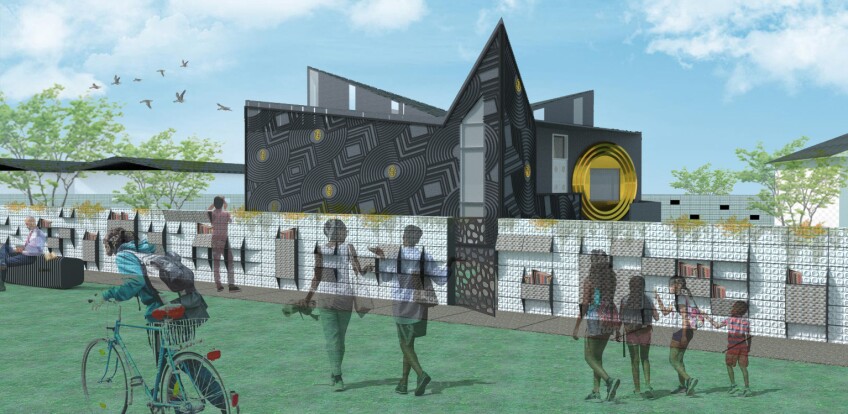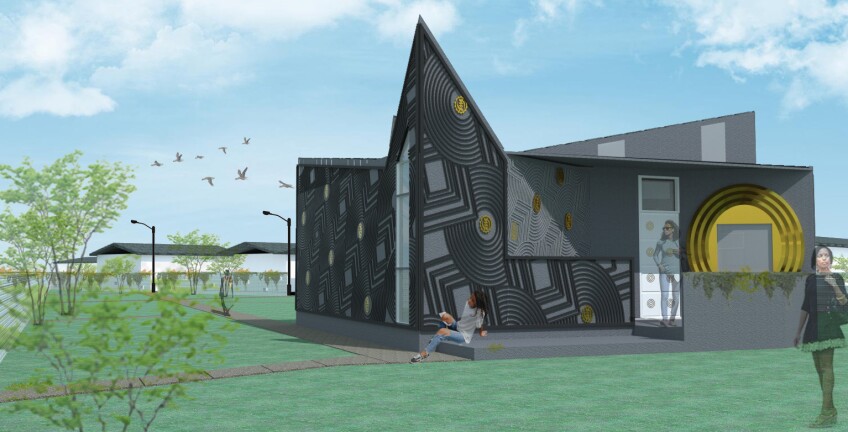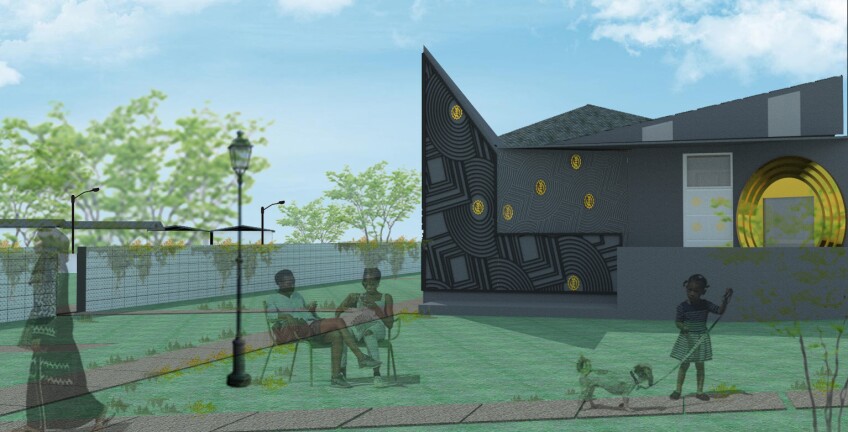A New Case Study House Puts Black Architecture on Display in Watts

On a triangle-shaped lot near the historic Watts Towers and the beloved Watts Towers Arts Center, a new mixed-use project is underway to add another arts and culture destination to the neighborhood. House No.1, the R Cloud House, aims not only to draw people from all over the city and beyond to experience the Black aesthetic through architecture but also to bring similar developments to other neighborhoods in the country. If it is difficult for you to envision what Black architecture is, can't visualize any examples at all or can only think of Black architects versus Black architecture, that's why this project, the first of nine planned case-study homes to be built in historically Black neighborhoods, is significant.
The project's architect is Demar Matthews, principal of offTOP Design. "We think of 'the hood' as Black neighborhoods. That's what most people think of when you say that and the negative connotation that comes with it," says the 2020 Woodbury University M. Arch graduate. "In Watts and Compton and South Central, the built-environment factors are bars on all your doors and windows, old buildings, you know, all these negatives, even the signs that you see, like 'No cruising.' These sorts of things are really relating to sort of a police state or incarcerated environment, prison-like environment," not features that empower the Black community — but examples of glaring inequalities.

Matthews has been reflecting on the question "What is Black architecture?" for the past few years and exploring factors that have impacted its development. At first, finding the answers to this question was the subject of his thesis project. While Black peers and advisors were vital to ensuring his designs would resonate with Black communities, he was the only Black student in his architecture program, and he had no Black professors at Woodbury. Considering only 2% of licensed architects are Black, it didn't surprise Matthews. "When I was showing things to people [at Woodbury], even if I was getting the highest praise, it didn't matter. I felt like, 'I can't have you judge Black architecture in the same sense." Matthews then started connecting with Black creatives across the country who have touched on the same subject matter (architecture, Black identity, urban environments, public spaces) and how they intersect, starting with Archinect writer Sean Joyner and architect Germane Barnes. Matthews' research included looking at the work of Melvin Mitchell, with whom he also corresponded. As Matthews started publishing his work on the subject, visual artist and architect Amanda Williams and architects James Garrett, Jr., of 4mula, Seikou Cook and Craig Wilkins reached out to him, "offering encouragement and advice." He'd send them his research and designs and ask, "Is this Black?"
Generations in the Making
Matthews' thesis project could simply have remained that: theory, were it not for a "truly serendipitous" meeting, in the words of longtime Watts resident Janine Watkins. Watkins and Matthews were introduced by his Woodbury University instructor and principal of NAC Architecture Michael Pinto in August 2019. Watkins is the daughter-in-law of Ted Watkins, Sr., a civil rights activist who founded the Watts Labor Action Committee (WLCAC) in 1965 after the Watts rebellion to better the lives of those in his community. Her husband, Tim Watkins, is now president of WLCAC. She and Pinto were already working together on the Watts' MudTown Farms project, a 2.5-acre agriculture park that will offer farm training and recreational programs to the public.

After Matthews shared his vision of architecture informed by the Black experience with "Miss Janine," as he calls her, Watkins told him, "You can build it here," referring to her quarter of an acre property on 107th Street. It has a large yard, a freestanding garage and a shotgun house, called the R Cloud House, where Watkins had hosted an artist-in-residence program in the past and where Matthews found the name for his first case study house. Watkins purchased the property in the early '90s to secure her own family's 100-year history in the neighborhood, with a priceless front-seat view of the Watts Towers. The landmark literally has her family's history embedded in it: "A lot of my aunts and uncles used to give Simon Rodia little pieces of plates to put in the Towers, and he would give them a penny for them."
From Watkins' perspective, who better to reimagine the property than a young Black architect who could also realize the goals of her generation: to preserve and explore Black history in Watts, expand Watts' positive cultural influence in the city and contribute to the well-being of its residents. "When I leave the planet, I want to know that I gave my experience in my life and my wisdom to Demar and other creators so they don't have to start all over again and suffer through something that I may have," says Watkins. "We all kind of get together, and the magic happens way beyond our imaginations. So we're hoping to make this project a prototype that we can share. And as we go through the country, young people can come forward and older people who have that experience that just make magic happen in regards to building out and engaging in [Black] content."
Expressing Black Culture in the Built Environment
Matthews' House No. 1, the R Cloud House, consists of a 700-square-foot ADU or accessory dwelling unit (a second home in a single-family lot) to serve as a revolving artist's residence. The shotgun house on the property would also be turned into a mixed-use creative and retail space, which would include a commercial kitchen. The garage would become a maker space. "The vision is for the space to be used by the community to continue to empower both art and entrepreneurship," he says. Community symmetry is important to Watkins, who is active in local development and co-chair of the Watts Neighborhood Council. These ideas were a result of merging his ideas of Black architecture with her commitment to community development, as well as those from community meetings.
Here's how Matthews enthusiastically explained the project to a third-grader one February afternoon:
We're going to turn this house into a space where the people who live here can sell food out of the house legally, and then this space in between the garage and the house, we're going to turn into a maker space for artists like you to produce art. Inside of the garage will be still a part of the maker space. We will have a couple of 3D printers, a laser cutter, a little podcast space…and the bathroom in there, and then right in this area, if everything goes how we have right now, this is where the ADU will be placed.
Specific elements in the R Cloud House visually represent the Black aesthetic in his renderings. The architectural facade is informed by Black hairstyles: box braids for women and waves for men. "Box braids are just so intricate and kind of geometric," he notes, marveling at how his 13-year-old niece has been doing them on herself since she was eight, achieving even slots every time. "There's a whole coded language around Black hairstyles that most people won't know. I look at his waves," pointing at one image he referenced for the ADU design, "and then I would say, 'That's dripping, and that lineup is crispy.' How do I put that on a building?"

He sees incorporating the hairstyles as also referencing African culture's celebration of patterns, emphasizing that while his case-study home is "speaking to Black American culture specifically, you cannot be Black without being of African descent." This enduring link continues with the gold Ghanaian adinkra symbols: "Our families will see these in Black spaces and South L.A., such as in Leimert Park and certain places in Watts" — placed in the patterns of the building's skin.
And from afar, the building's shape, with its roof's multiple jutting angles, mimics a crown, which "speaks to the value of the person wearing it in the sense of classical paintings," Matthews says. The crown motif is also found in contemporary Black art, from Jean Michel Basquiat's paintings to Barron Claiborne's iconic "King of New York" portrait of Biggie Smalls. Beyoncé fittingly dons crowns in her performances and videos, and the design of the National Museum of African American History and Culture by Ghanian-British architect Sir David Adjaye, together with Philip Freelon and J. Max Bond, Jr., took inspiration from Yoruban art that featured three-tiered crowns.

More and more, conversations about how built environments affect and are also shaped by communities of color are happening. Architects Williams, Barnes and Cooke have works in MoMA's current exhibit, "Reconstructions: Architecture and Blackness in America," which explores how contemporary architecture has impacted Black communities. With Watkins' commitment to his case study, Matthews knows he's in a very unique position as a recent graduate. He has a concept that will actually be built in the next year, not just a model or renderings to exhibit for critique. "They kind of teach you [in school] that there's only one path to something. You just go to a firm, work 10 years, and then you'll get to build your first building … I was just not into that," said Matthews. What's more, it'll be accessible to the Black and Brown residents of South L.A., as well as the more than 45,000 people visiting the Watts Towers each year. Matthews also launched a GoFundMe last year, with L.A.'s A+D Museum as its fiscal sponsor, and continues to apply for grants, sponsorships and entering design competitions to help ensure financial stability when it comes to the construction phase.
Both Watkins and Matthews hope the ADU will stand out as a Black landmark that people of all backgrounds will embrace. While there are numerous landmarks in Los Angeles designed by Black architects — from Paul R. Williams' contributions to the LAX Theme Building and Elliot S. Barker's Martin Luther King J. Transit Station to trailblazer Norma Merrick Sklarek's collaboration with Cesar Pelli on the Pacific Design Center — R Cloud House has no commercial client or city agency setting priorities or directing the project (save in permitting).
Balancing Community Needs with Personal Expression
Matthews and Watkins have a number of participating design sponsors for the project: Gensler for renovations and remodels to the shotgun house and garage; Steinberg Heart is providing logistical support for the ADU; and Studio M-LA will be involved in the landscape design. Matthews couldn't have a more stellar team to join him on this journey to realize the first Black aesthetic case-study home. But for Matthews and Watkins, the most vital partner is the surrounding community, and they're actively working to bring in more local organizations into the fold. "The idea really is how can we use one piece of property to address a community's major needs, in terms of lack of resources, in terms of providing both educational and health and wellness opportunities," he explains, while applying a Black design to it. This led to one-on-one conversations and small meetings with local leaders and activists, such as Naima Greffon, vice president of the Greater Watts Development Corporation, an arm of the WLCAC.
The Watts community and organizations like WLCAC have been pushing for further development in the area around the Watts Towers for decades. But the city has failed, says both Watkins and Greffon, time and again to move on projects that would specifically benefit the neighborhood. Greffon mentions a strip of land next to Watkins' property, an undeveloped and unmaintained stretch of dirt and weeds owned by the city, as an obvious example, and the potential for more displacement and gentrification in Watts due to newly approved housing developments that don't prioritize its residents: "There's a lot of housing development here, because the city needs housing, but not Watts. Watts shouldn't need to provide housing to the entire city of L.A.," Greffon says, feeling that the buildings are really targeting workers in downtown who can't afford to live there. "That's what the community is feeling. Developers are destroying all that is pertaining to the African American culture. And there are a lot of old buildings being demolished and are being proposed to be used for other purposes than preserving the neighborhood's history. And that's a big concern for the community."

Matthews, who lives between Koreatown and East Hollywood, has engaged with the community around the Towers, stopping people of all ages to hear what it is like to live in Watts and what would make them thrive versus Watts' motto of We Are Taught to Survive. "I've had conversations with people who are telling me what it's like to live there. Some people were saying there's not enough healthy food here," Matthews shares. "I've had conversations about or with homeless people about having a place to get fresh fruits and vegetables. There have been conversations about having a place for young artists to exhibit." That's how the interactive fence became introduced to his design, which includes a vertical garden with fruits and vegetables, a public lending library, and exhibit space for the artist in residence and local artists that South L.A. collective Dreamhaus will oversee art. Matthews will continue to develop the fence line more as more community members chime in. (Large meetings were halted due to the pandemic, and they've just started launching Zoom meetings open to the public.)
"I'm just trying to speak to everything positive about being Black. I think that this architecture has the power to be able to have Black excellence on display. Black boys and Black girls will be able to look at a building and see their culture reflected and see their likeness in that building. I think that would be a good thing for a lot of us. I think there’s a lot of power in that."Demar Matthews
Watkins couldn't be more excited about her property's future. On a recent Zoom community chat in mid-February, she reminded the audience that investing in younger generations — young talent, like Matthews — create catalysts for change: "You teach a child to draw, you allow a child to gravitate to what their niches are so that we create our own visions. I think that people of color who have been oppressed and suppressed need to understand it's all in your mind," she said, "in the sense that you can overcome that, just by having vision and perseverance. We need to design our lifestyles, we need to design our healing, we need to design our trust and collective communities as opposed to allowing others to design it for us."
Of course, Matthews couldn't agree more. He hopes this project will impact multiple generations in profound ways: "I'm just trying to speak to everything positive about being Black. I think that this architecture has the power to be able to have Black excellence on display," says the architect. "Black boys and Black girls will be able to look at a building and see their culture reflected and see their likeness in that building. I think that would be a good thing for a lot of us. I think there's a lot of power in that."
offTOP Design will be hosting more community discussions in March, tentatively scheduled for the 6th and 20th. Follow offTOP for updates.







